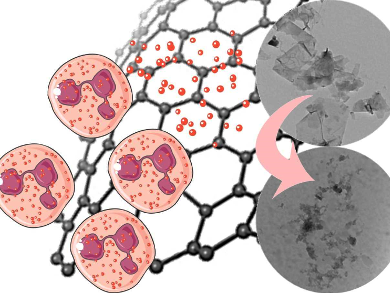Graphene is considered the material of the future. As widespread use and industrial scale production of graphene and its derivatives becomes common place, people and the environment face increased exposure to these materials, which present toxicity and mutagenicity risks. Biodegradability is one of the crucial factors that decides the fate of graphene in living organisms.
Alberto Bianco, University of Strasbourg, France, and co-workers have discovered that two types of graphene—water-dispersible single-layer and few-layered graphene, without either chemical functionalization or stabilizing surfactants—are degraded by a human enzyme. In an in vitro (or test tube) model, the team used the extracted human enzyme myeloperoxidase (hMPO) to biodegrade the types of graphene.
The two graphene samples were dispersed in phosphate buffer and treated with hMPO and hydrogen peroxide. Raman spectroscopy and electron microscopy revealed degradation of pristine graphene after 24 hours, and considerable dispersion after 40 hours.
Biodegradation was also demonstrated in the presence of activated, degranulating human neutrophils—a type of immune cell that fights infection by excreting hMPO. The researchers believe the findings provide important information about the safety of graphene in biological systems.
- Degradation of Single-Layer and Few-Layer Graphene by Neutrophil Myeloperoxidase,
Rajendra Kurapati, Sourav P. Mukherjee, Cristina Martín, George Bepete, Ester Vázquez, Alain Pénicaud, Bengt Fadeel, Alberto Bianco,
Angew. Chem. Int. Ed. 2018.
https://doi.org/10.1002/anie.201806906




